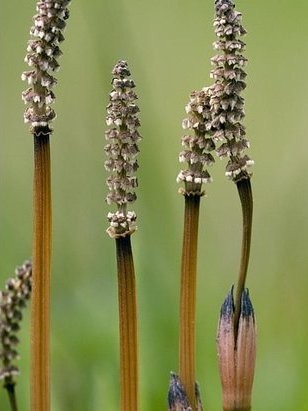Common horsetail
(Equisetum arvense arvense)

Description
Equisetum arvense, the field horsetail or common horsetail, is an herbaceous perennial plant in the Equisetidae (horsetails) sub-class, native throughout the arctic and temperate regions of the Northern Hemisphere. It has separate sterile non-reproductive and fertile spore-bearing stems growing from a perennial underground rhizomatous stem system. The fertile stems are produced in early spring and are non-photosynthetic, while the green sterile stems start to grow after the fertile stems have wilted and persist through the summer until the first autumn frosts. It is sometimes confused with mare's tail, Hippuris vulgaris. The specific epithet arvense is from the Latin "arvum", meaning "ploughed", referencing the growth of the plant in arable soil or disturbed areas. The common name "common horsetail" references the appearance of the plant that when bunched together appears similar to a horse's tail. Equisetum arvense creeps extensively with its slender and felted rhizomes that freely fork and bear tubers. The erect or prostrate sterile stems are 10–90 cm (3.9–35.4 in) tall and 3–5 mm (0.12–0.20 in) diameter, with jointed segments around 2–5 cm (0.79–1.97 in) long with whorls of side shoots at the segment joints; the side shoots have a diameter of about 1 mm (0.039 in). Some stems can have as many as 20 segments. The solid and simple branches are ascending or spreading, with sheaths that bear attenuate teeth. The off-white fertile stems are of a succulent texture, 10–25 cm (3.9–9.8 in) tall and 3–5 mm (0.12–0.20 in) diameter, with 4–8 whorls of brown scale leaves and an apical brown spore cone. The cone is 10–40 mm (0.39–1.57 in) long and 4–9 mm (0.16–0.35 in) broad. The fertile stems are typically precocious and appear in early spring. It has changed little from its ancestors of the Carboniferous period. The plant is difficult to control due to its extensive rhizomes and deeply buried tubers. Fire, mowing, or slashing is ineffective at removing the plant as new stems quickly grow from the rhizomes. Some herbicides remove aerial growth but regrowth quickly occurs albeit with a reduction in frond density. E. arvense is a nonflowering plant, multiplying through spores. It absorbs silicon from the soil, which is rare among herbs. It has a very high diploid number of 216 (108 pairs of chromosomes).
Taxonomic tree:







